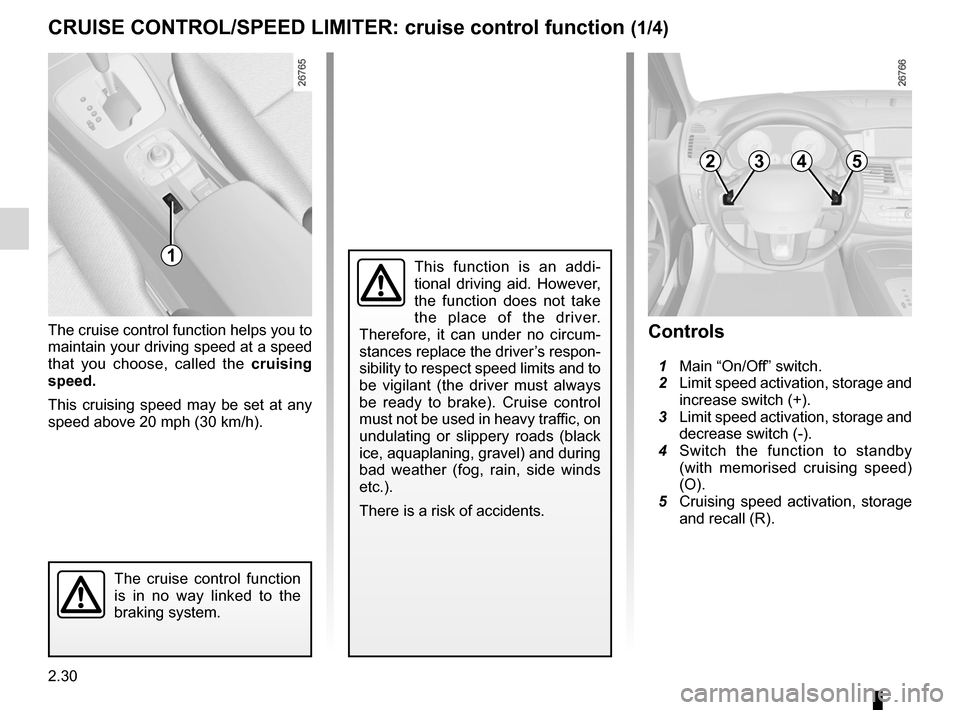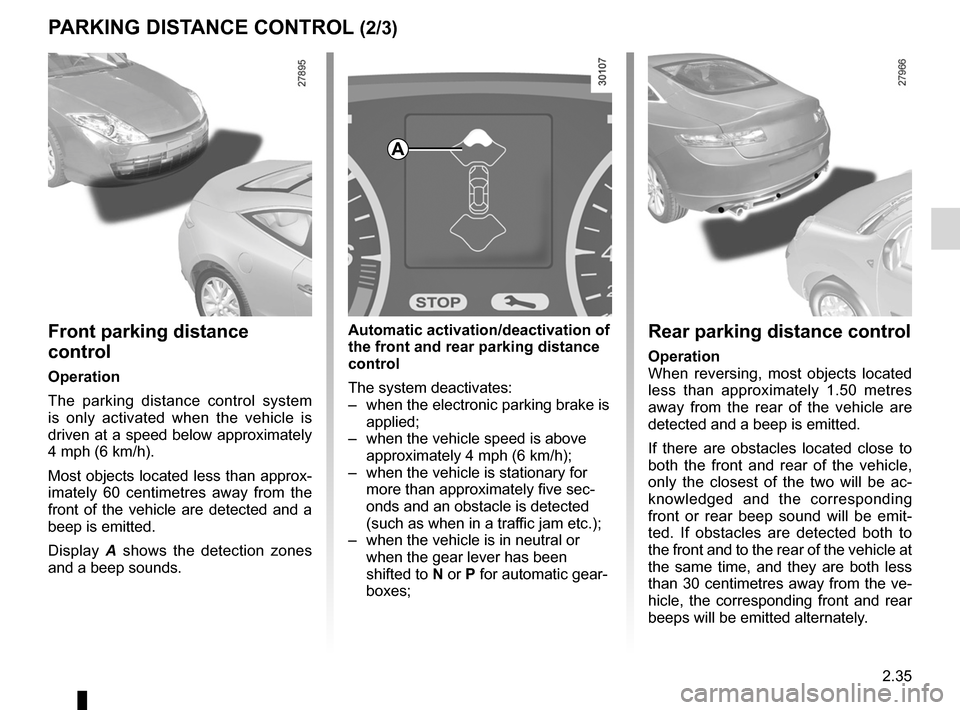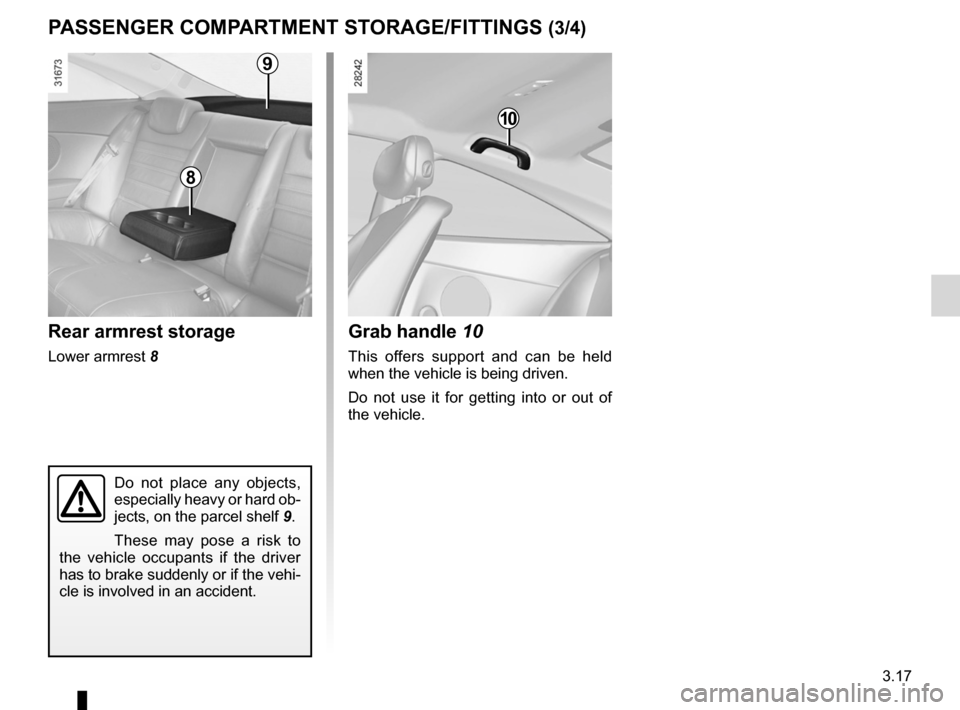2012 RENAULT LAGUNA COUPE ESP
[x] Cancel search: ESPPage 100 of 221

ABS ...................................................... (up to the end of the DU)
anti-lock braking system: ABS ..............(up to the end of the DU)
emergency brake assist ........................(up to the end of the DU)
emergency braking ............................... (up to the end of the DU)
driving ................................................... (up to the end of the DU)
ASR (traction control) ........................... (up to the end of the DU)
traction control: ASR .............................(up to the end of the DU)
traction control system: ASR ................(up to the end of the DU)
electronic stability control: ESC ............ (up to the end of the DU)
ESC: electronic stability control ............ (up to the end of the DU)
Hill Start Assist...................................... (up to the end of the DU)
2.22
ENG_UD27695_10
Dispositifs de correction et d’assistance à la de conduite (X91 -\
B91 - K91 - D91 - Renault)
ENG_NU_939-3_D91_Renault_2
Jaune NoirNoir texte
aBS (anti-lock braking
system)
Under heavy braking, the ABS prevents
the wheels from locking, allowing the
stopping distance to be managed and
keeping control of the vehicle.
Under these circumstances, the vehi -
cle can be steered to avoid an obstacle
whilst braking. In addition, this system
can increase stopping distances, par -
ticularly on roads with low surface grip
(wet ground etc.).
You will feel a pulsation through the
brake pedal each time the system is
activated. The ABS does not in any way
improve the vehicle's physical perform-
ance relating to the road surface and
roadholding. It is still essential to follow
the rules of good driving practice (such
as driving at a safe distance from the
vehicle in front etc.).
Driver correction devices and aids
DRIVeR CoRReCtIoN DeVICeS aND aIDS (1/5)
Depending on the vehicle, they may
comprise:
– t h e aB S ( a n t i - l o c k b r a k i n g
system);
– eSC (electronic stability program)
with understeer control and a SR
traction control;
– emergency brake assist with, de -
pending on the vehicle, braking
anticipation;
– rear wheel steering.
In an emergency, apply firm and
continuous pressure to the brake
pedal. There is no need to pump
it repeatedly. The ABS will modu -
late the force applied in the braking
system.
These functions are an ad-
ditional aid in the event of
critical driving conditions,
enabling the vehicle behav -
iour to be adapted to suit the driving
conditions.
However, the functions do not take
the place of the driver. they do
not increase the vehicle’s limits
and should not encourage you
to drive more quickly. Therefore,
they can under no circumstances
replace the vigilance or responsibil -
ity of the driver when manoeuvring
the vehicle (the driver must always
be ready for sudden incidents which
may occur when driving).
Yo u r b r a k i n g s y s t e m s
are partially operational.
However, it is dangerous
to brake suddenly and
it is essential to stop immediately,
as soon as traffic conditions allow.
Contact an approved dealer.
operating faults:
–
© and x lit up on the in -
strument panel alongside mes -
sages “Check ABS”, “Check braking
system” and “Check ESC”: indicates
the ABS, ESC and emergency brake
assist are deactivated. Braking is
always enabled;
–
x, D, © and ® lit
up on the instrument panel alongside
the message “Braking system fault”:
this indicates a fault in the braking
system.
In both cases, consult an approved
dealer.
Page 108 of 221

cruise control ........................................ (up to the end of the DU)
cruise control-speed limiter................... (up to the end of the DU)
driving ................................................... (up to the end of the DU)
2.30
ENG_UD22201_5
Régulateur-limiteur de vitesse : fonction régulateur (X91 - B91 -\
K91 - Renault)
ENG_NU_939-3_D91_Renault_2
Jaune NoirNoir texte
Cruise control
CRUISe CoNtRoL/SPeeD LIMIteR: cruise control function (1/4)
The cruise control function helps you to
maintain your driving speed at a speed
that you choose, called the cruising
speed.
This cruising speed may be set at any
speed above 20 mph (30 km/h).
The cruise control function
is in no way linked to the
braking system.
This function is an addi -
tional driving aid. However,
the function does not take
the place of the driver.
Therefore, it can under no circum -
stances replace the driver’s respon-
sibility to respect speed limits and to
be vigilant (the driver must always
be ready to brake). Cruise control
must not be used in heavy traffic, on
undulating or slippery roads (black
ice, aquaplaning, gravel) and during
bad weather (fog, rain, side winds
etc.).
There is a risk of accidents.
Controls
1 Main “On/Off” switch.
2 Limit speed activation, storage and
increase switch (+).
3 Limit speed activation, storage and
decrease switch (-).
4 Switch the function to standby
(with memorised cruising speed)
(O).
5 Cruising speed activation, storage
and recall (R).
2354
1
Page 112 of 221

parking distance control........................(up to the end of the DU)
driving ................................................... (up to the end of the DU)
reversing sensor ................................... (up to the end of the DU)
2.34
ENG_UD27734_1
Aide au parking (X91 - D91 - Renault)
ENG_NU_939-3_D91_Renault_2
Jaune NoirNoir texte
Parking distance control
This function is an additional aid that indicates the distance between the
vehicle and an obstacle whilst reversing, using sound signals.
Under no circumstances should it replace the driver’s care or responsibil -
ity whilst reversing.
The driver should always look out for sudden hazards during driving: always
ensure that there are no moving obstacles (such as a child, animal, pram or bi-
cycle, etc.) or small, narrow objects such as stones or posts in your path when
manoeuvring.
operating principle
Ultrasonic detectors, installed in the
front or rear bumper depending on the
vehicle, measure the distance between
the vehicle and an obstacle whilst re -
versing.
This measurement is indicated by
beeps which become more frequent the
closer you come to the obstacle, until
they become a continuous beep when
the vehicle is approximately 25 centi -
metres from the obstacle.
P aRKING DIStaNCe CoNtRoL (1/3)
1
2
adjusting the parking
distance control volume
From the vehicle settings customisation
menu (refer to “vehicle settings cus -
tomisation menu” in Section 1), select
the line for the parking distance control
volume, adjust the volume and press
key 1 or 2 to confirm.
Page 113 of 221

JauneNoirNoir texte
2.35
ENG_UD27734_1
Aide au parking (X91 - D91 - Renault)
ENG_NU_939-3_D91_Renault_2
P aRKING DIStaNCe CoNtRoL (2/3)
Rear parking distance control
operation
When reversing, most objects located
less than approximately 1.50 metres
away from the rear of the vehicle are
detected and a beep is emitted.
If there are obstacles located close to
both the front and rear of the vehicle,
only the closest of the two will be ac -
knowledged and the corresponding
front or rear beep sound will be emit -
ted. If obstacles are detected both to
the front and to the rear of the vehicle at
the same time, and they are both less
than 30 centimetres away from the ve-
hicle, the corresponding front and rear
beeps will be emitted alternately.
automatic activation/deactivation of
the front and rear parking distance
control
The system deactivates:
– when the electronic parking brake is
applied;
– when the vehicle speed is above
approximately 4 mph (6 km/h);
– when the vehicle is stationary for
more than approximately five sec -
onds and an obstacle is detected
(such as when in a traffic jam etc.);
– when the vehicle is in neutral or
when the gear lever has been
shifted to N or P for automatic gear-
boxes;Front parking distance
control
operation
The parking distance control system
is only activated when the vehicle is
driven at a speed below approximately
4 mph (6 km/h).
Most objects located less than approx-
imately 60 centimetres away from the
front of the vehicle are detected and a
beep is emitted.
Display A shows the detection zones
and a beep sounds.
a
Page 116 of 221

2.38
ENG_UD27633_9
Boîte de vitesses automatique (X91 - B91 - K91 - D91 - Renault)
ENG_NU_939-3_D91_Renault_2
Jaune NoirNoir texte
Parking the vehicle
When the vehicle is stopped, move the
lever to position P while keeping your
foot on the brake pedal: the gearbox is
in neutral and the drive wheels are me-
chanically locked by the driveshaft.
a pply the handbrake or, depending
on the vehicle, ensure that the elec-
tronic parking brake is applied.
Special circumstances
– If the road contours and bends
do not allow you to stay in auto -
matic mode (e.g.: in the mountains),
we recommend that you change to
manual mode.
This will prevent the automatic gear-
box from changing gears repeatedly
when climbing, and permit engine
braking on long descents.
– In cold weather , to prevent the
engine from stalling, wait a few mo-
ments before shifting the selector
lever from position P or N and en -
gaging D or R.
– Vehicles not fitted with traction
control: on a slippery surface or
surface with a low level of adhe -
sion, change to manual mode and
select second gear before starting
the engine to avoid wheelspin when
starting.
Driving in manual mode
With the selector lever in position D,
move the lever to the left. Shifting the
lever repeatedly allows you to change
gears manually:
– To move down through the gears,
push the lever backwards;
– To move up through the gears, push
the lever forwards.
The gear selected is displayed on the
instrument panel.
Special cases
Under certain driving conditions (e.g.
engine protection, electronic stability
program (ESP) operational etc.: ESC),
the “automatic system” may change
gear automatically.
Likewise, to prevent incorrect manoeu -
vres, a gear change may be refused by
the automatic system: in this case the
gear display flashes for a few seconds
as a warning.
aUtoMatIC GeaRBox (2/3)
An impact to the underside
of the vehicle (e.g.: striking
a post, raised kerb or other
street furniture) may result
in damage to the vehicle (e.g.: de -
formation of an axle).
To avoid any risk of accident, have
your vehicle checked by an ap -
proved Dealer.
In very cold weather, the system
may prevent the gears from being
shifted in manual mode until the
gearbox reaches the right tempera-
ture.
Page 128 of 221

3.10
ENG_UD10081_2
Air conditionné : informations et conseils d’utilisation (X91 - B91 - K91 - Renault)
ENG_NU_939-3_D91_Renault_3
Air conditioning: information and advice on use
AIR coNDITIoNINg: information and advice on use
Fuel consumption
You will normally notice an increase
in fuel consumption (especially
when driving in town) when the air
conditioning is operating.
For vehicles fitted with manual air
conditioning, switch off the system
when it is not required.
Advice for reducing
consumption and therefore
helping to preserve the
environment:
Drive with the air vents open and
the windows closed.
If the vehicle has been parked in
the sun, open the doors for a few
moments to let the hot air escape
before starting the engine.
Maintenance
Refer to the Maintenance Document
for your vehicle for the inspection
frequency.operating faults
As a general rule, contact your ap-
proved Dealer in the event of an op-
erating fault:
– reduction in de-icing, demist -
ing or air conditioning per -
formance. This may be caused
by the passenger compartment
filter cartridge becoming clogged;
– no cold air is being produced.
Check that the controls are set
correctly and that the fuses are
sound. Otherwise, switch off the
system.
Advice on use
In some situations, (air conditioning
off, air recirculation activated, venti-
lation speed at zero or low, etc.) you
may notice that condensation starts
to form on the windows and wind -
screen.
If there is condensation, use the
“clear View” function to remove it,
then use the air conditioning in auto-
matic mode to stop it forming again.
If the condensation does not clear,
use the FAST programme.
Do not open the refriger -
ant fluid circuit. The fluid
may damage eyes or skin.
Note
Presence of water under the ve -
hicle. After prolonged use of the air
conditioning system, it is normal for
water to be present under the vehi-
cle. This is caused by condensation.
Page 129 of 221

electric windows ................................... (up to the end of the DU)
child safety ............................................................. (current page)
children (safety) .................................... (up to the end of the DU)
3.11
ENG_UD22219_4
Lève-vitres électriques (X91 - D91 - Renault)
ENG_NU_939-3_D91_Renault_3
Electric windows
ElEcTRIc WINDoWS (1/2)
With the ignition on, press the switch
for the window concerned to lower it to
the desired height.
Lift the switch to raise the window to the
desired height.
From the driver’s seat
Operate the switches as follows:
1 for the driver’s side;
2 for the passenger side.
From the front passenger seat
Press switch 3.
1
23
one-touch windows
The one-touch mode works in addition
to the operation of the electric windows
described previously.
– Fully press down (beyond the
notch) on the relevant switch: the
window will open completely.
– Fully lift (beyond the notch) the
relevant switch up: the window will
close completely.
Pressing the switch again while the
window is moving will stop its move -
ment.
Note: If the window detects resistance
when closing (e.g.: fingers, branch of
a tree, etc.) it stops and then lowers
again by a few centimetres.
These systems operate up to approxi -
mately 5 minutes after the engine is
switched off or until a door is opened.
If any part of the body be -
comes trapped, reverse the
direction of the window im -
mediately by pressing the
relevant switch.
Driver’s responsibility
Never leave your vehicle
with the RENAULT card
inside and never leave a
child (or a pet) unsupervised, even
for a short while.
They may pose a risk to themselves
or to others by starting the engine,
activating equipment such as the
electric windows or by locking the
doors.
Risk of serious injury.
Page 135 of 221

armrest:rear .................................................................. (current page)
JauneNoirNoir texte
3.17
ENG_UD25102_1
Rangements, aménagements habitacle (X91 - D91 - Renault)
ENG_NU_939-3_D91_Renault_3
P ASSENgER coMPARTMENT ST oRAgE/FITTINgS (3/4)
10
grab handle 10
This offers support and can be held
when the vehicle is being driven.
Do not use it for getting into or out of
the vehicle.
Rear armrest storage
Lower armrest 8
Do not place any objects,
especially heavy or hard ob-
jects, on the parcel shelf 9.
These may pose a risk to
the vehicle occupants if the driver
has to brake suddenly or if the vehi-
cle is involved in an accident.
8
9